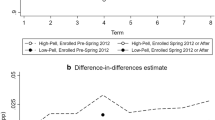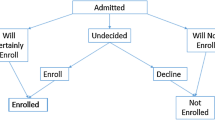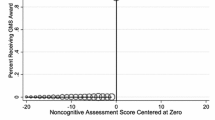Abstract
This paper exploits uniquely detailed data and cross-institution variation in aid for three large public universities to identify the effects of aid on the probability of college graduation. The results indicate that need-based and merit-based aid both increase graduation rates at large public institutions, but primarily through the types of students that ‘select’ these institutions. Merit-based aid facilitates an institution attracting students who have higher observed academic ability that raises the probability of graduation. Need-based aid enables an institution to attract students with non-academic attributes such as social and cultural networks that, while often unobserved, improve graduation success. Broadly, our results suggest that recent aid policy that has moved away from need-based aid for low-income students (reducing their ability to find the best institutional match) and toward merit-based aid (that alters the distribution of high ability students across colleges) could foster stagnant graduation rates even with rising enrollment rates that have been observed over the last three decades.

Similar content being viewed by others
Notes
There may be a variety of reasons why students fail to fill out a FAFSA that are related to eligibility for aid (e.g., lack of knowledge about aid availability or filing procedures and deadlines). However, our evidence suggests these cases are unlikely to represent a significant portion of non-FAFSA applicants, as students in our sample who do not fill out a FAFSA are similar to FAFSA filers in terms of pre-enrollment academic credentials, having slightly lower high school GPAs and high school class ranks, but slightly higher SAT scores. As expected, non-filers originate from areas with significantly higher median incomes than filers and receive essentially no need-based financial aid.
The 3,206 individuals excluded from the sample are qualitatively similar to those retained in the sample in important attributes such as high school class rank, high school GPA, median household income and total first-year financial aid. There were 195 of 3,206 excluded observations that were dropped due to missing values of first year college GPA. Presumably, these students dropped out too early to compile a first semester GPA. Although in general, excluding premature dropouts may overstate the true effect of aid, they constitute only 1.7% of all enrollees. Also, these students descriptively tend to be relatively bright, well-to-do students majoring in difficult technical subjects—observations inconsistent with the notion they have limited chances for success and little ability to respond positively to aid.
While the means of average eligibility and average need-based aid are numerically similar for the sample of enrollees ($5,377 vs. $5,101), the distributions of these variables differ substantially (e.g. the standard deviation of eligibility is nearly $1,000 greater than that of need-based aid), illustrating the role of need-based aid in equalizing income differences across students. Although eligibility and need-based aid are highly correlated (i.e., ρ = 0.75), instrumental variables techniques exploit the exogenous (independent) variation in these need measures reflected in their distributional differences to identify their separate graduation effects. Moreover, high collinearity between predicted aid and eligibility inflates the standard errors, which can yield insignificant (but not wrong-signed) coefficients. The significance of these aid variables in the graduation models (presented subsequently) suggests that multicollinearity is not an issue.
Graduation rates are nearly identical at UO and IU (55.4% and 55.6%, respectively) but somewhat higher at CU (63.2%). Similarly, average first year need-based aid is similar among enrollees at UO and IU ($6572 and $6511, respectively) but higher at CU ($8986). Average first year merit aid is also similar among UO and IU enrollees ($181 and $171, respectively) but significantly higher at CU ($480). The percentage variation in both types of aid between CU and the other two schools is large even relative to the percentage variation in graduation rates. This, along with the fact that high school class ranks are very similar across institutions (78th percentile at UO, 80th percentile at IU, and 81st percentile at CU) lends support to the assertion that similar students at different schools receive different amounts of aid.
Even if SAT score is correlated with latent graduation-enhancing attributes, the inclusion of the inverse Mills ratio in the graduation model acts as a filter on this correlation if the latent attributes in question are time-invariant and also affect enrollment. Time-varying shocks that occur during college and affect graduation (for example, a parent passing away or losing a job) are clearly uncorrelated with SAT scores.
We explicitly incorporate time variation in aid (for a given student) into our model by estimating second through fifth year aid as a function of year in school. This accounts for systematic or unsystematic changes in aid that may occur over the course of a college career, due to changes in federal guidelines, institutional policies and practices, and so on. Furthermore, the instrumental variables construction predicts time variation in aid that is exogenous with respect to unobserved time-varying characteristics of the student. We average the predicted aid values over five years of college in order to obtain a single measure of aid with which to explain the single dichotomous outcome of graduation. Averaging also increases the efficiency of the estimates by “washing out” measurement error occurring at particular points in time.
There are other potential sources of selection. For example, enrollment results may be driven by selection bias in the decision to apply (e.g., the marketing and recruiting activities of colleges that give students an idea of their potential financial aid packages prior to application), which cannot be tested due to a lack of non-applicant data. Likewise, geographic differences in large public institutions (e.g., heavy competition between the private and public sectors in the northeast that could amplify the marginal effect of aid and a history of discrimination in the south that could lead to significant racial differences in the effects of aid) may limit external validity. It follows that we can best generalize to the population of financially needy applicants to “similar” institutions.
The usual OLS formulae for the standard errors in the graduation equation are biased because of the presence of predicted values of the aid variables and the heteroskedasticity naturally arising from a dichotomous dependent variable. Thus, we bootstrap the standard errors, a non-parametric technique well-suited to cases in which the mean and variance of the error term are unknown. By repeatedly sampling randomly from the available data, the bootstrapping approach obtains the “empirical distribution” for the standard error of each coefficient. We report the mean of this distribution as the estimated standard error.
This result may also imply administrators can increase graduation rates by “funneling” students to professional majors that, while benefiting particular institutions and departments, is of dubious social value. In this case we are unable to directly test whether administrators actually behave in this fashion.
Several studies find non-financial factors affect retention, including the student’s family structure and socioeconomic background (Ver Ploeg, 2002), the gender composition and teaching ability of the institution’s faculty (Langbein & Snider, 1999; Robst, Keil, & Russo, 1998), and to what extent there is a match between the ability of students and the quality of the college (Light & Strayer, 2000).
Average yearly in-state tuitions at these institutions over the sample period (1994–2000) are as follows: Colorado: $2941; Indiana: $3905; Oregon: $3605. Average yearly out-of-state tuitions are: Colorado: $14,919; Indiana: $11,827; Oregon: $12,189. Thus, $1000 of aid in any given year is more than a quarter of average in-state tuition and between 6.7% and 8.2% of out-of-state tuition at each of these institutions.
References
Archibald, R. B. (2002). Redesigning the financial aid system: Why colleges and universities should switch roes with the federal government. (Baltimore and London: Johns Hopkins University Press).
Bettinger, E. (2004). ‘How financial aid affects persistence’, Working Paper 10242, National Bureau of Economic Research.
Bettinger, E., & Long B. T. (2005). ‘Addressing the needs of under-prepared students in higher education: Does college remediation work?’, Working Paper 11325, National Bureau of Economic Research.
Bound, J., & Turner, S. (2002). Going to war and going to college: Did World War II and the GI bill increase educational attainment for returning Veterans? Journal of Labor Economics, 20, 784–815.
Boyd, L. (1997). Discrimination in mortgage lending: The impact on minority defaults in the stafford loan program. Quarterly Review of Economics and Finance, 37, 23–37.
Braunstein, A., McGrath, M., & Pescatrice, D. (1999). Measuring the impact of income and financial aid offers on college enrollment decisions. Research in Higher Education, 40, 247–259.
Braunstein, A., McGrath, M., & Pescatrice, D. (2001). Measuring the impact of financial factors on college persistence. Journal of College Student Retention, 2, 191–203.
Cabrera, A. (1990). ‘Determinants of persistence: The inclusion and testing of ability to pay factors in tinto’s model of student attrition’, Paper presented at the Annual Meeting of the Association for the Study of Higher Education, Portland, OR, November 1–4, 1990.
Cabrera, A. (1992). ‘The role of finances in the persistence process: A structural model’, Paper presented at the Annual Meeting of the American Educational Research Association, San Francisco, CA, April 20–24, 1992.
Clark, W. (1999). Paying off student loans. Perspectives on Labour and Income, 11, 28–33.
Davis, J. S., & Johns, K. Jr. (1982). Low family income: A continuing barrier to college enrollment. Journal of Student Financial Aid, 12, 5–10.
DesJardins, S. L., Ahlburg, D. A. & McCall, B. P. (1999). An event history model of student departure. Economics of Education Review, 18, 375–390.
Dynarski, S. (2003). Does aid matter? Measuring the effect of student aid on college attendance and completion. American Economic Review, 93, 279–288.
Frazis, H. (1993). Selection bias and the degree effect. Journal of Human Resources, 28, 538–554.
Heller, D. E. (1997). Student price response in higher education: An update to Leslie and Brinkman. Journal of Higher Education, 68, 624–659.
Hilmer, M. J. (2001). Redistributive fee increases, net attendance costs and the distribution of students at the Public University. Economics of Education Review, 20, 551–562.
Hungerford, T., & Solon, G. (1987). Sheepskin effects in the returns to education. Review of Economics and Statistics, 69, 175–177.
Jackson, G. A. (1978). Financial aid and student enrollment. Journal of Higher Education, 49, 548–574.
Jensen, E. (1983). Financial aid and educational outcomes: A Review. College and University 287–303.
Kane, T. (1994). College entry by blacks since 1970: The role of college costs, family background and the returns to education. Journal of Political Economy, 102, 878–911.
Kane, T. (2003). ‘A Quasi-experimental estimate of the impact of financial aid on college-going’, Working Paper 9703, National Bureau of Economic Research.
Kramer, M. A. (1998). Linking access and aspirations: The dual purpose of pell grants. In L. E. Gladieux, B. Astor, & W. S. Swail (Eds.), Memory, reason, imagination: A quarter century of Pell Grants. (New York: College Entrance Examination Board).
Langbein, L. I., & Snider, K. (1999). The impact of teaching on retention: Some quantitative evidence. Social Science Quarterly, 80, 457–472.
Leslie, L. L., & Brinkman, P. T. (1987). Student price response in higher education: The student demand studies. Journal of Higher Education, 58, 181–204.
Leslie, L. L., & Brinkman, P. T. (1988). The economic value of higher education. (San Francisco: Jossey-Bass).
Light, A., & Strayer, W. (2000). Determinants of college completion. Journal of Human Resources, 35, 299–332.
Manski, C., & Wise, D. (1983). College choice in America. (Cambridge, MA: Harvard University Press).
McPherson, M. S., & Schapiro, M. O. (1998). The sudent aid game. Princeton, NJ: Princeton University Press.
National Center for Education Statistics. (2006). Digest of education statistics. http://nces.ed.gov/programs/digest/d04/tables/dt04_182.asp. Accessed January 26, 2006.
Pope, J. (2005). ‘College graduation rates under study’, The Associated Press November 16, 2005.
Robst, J., Keil, J., & Russo, D. (1998). The effect of gender composition of faculty on student retention. Economics of Education Review, 17, 429–439.
St. John, E. P. (1989). The evolving influence of student financial aid on persistence. Journal of Student Financial Aid, 19, 52–68.
St. John, E. P. (1990a). Price response in enrollment decisions: An analysis of the high school and beyond sophomore cohort. Research in Higher Education, 31, 161–176.
St. John, E. P. (1990b). Price response in persistence decisions: An analysis of the high school and beyond senior cohort. Research in Higher Education, 31, 387–403.
St. John, E. P., & Noell, J. (1989). The impact of student aid on access to higher education: An analysis of progress with special consideration of minority enrollment. Research in Higher Education, 30, 563–581.
St. John, E. P., Andrieu, S., Oescher, J., & Starkey, J. B. (1994). The influence of student aid on within-year persistence by traditional college-age students in four-year colleges. Research in Higher Education, 35, 455–480.
St. John, E. P., & Starkey, J. B. (1995). An alternative to net price: Assessing the influence of prices and subsidies on within-year persistence. Journal of Higher Education, 66, 156–186.
Schwartz, J. B. (1985). Student financial aid and the college enrollment decision: The effects of public and private grants and interest subsidies. Economics of Education Review, 4, 129–144.
Seftor, N., & Turner, S. (2002). Back to school: Federal student aid policy and adult college enrollment. Journal of Human Resources, 37, 336–352.
Singell, L. D. Jr. (2002). Merit, need and student self-selection: Is there discretion in the packaging of aid at a large public university? Economics of Education Review, 21, 445–454.
Singell, L. D. Jr. (2004). Come and stay a while: Does financial aid effect enrollment and retention at a large public university? Economics of Education Review, 23, 459–472.
Stanley, M. (2003). College education and the mid-century GI bills. Quarterly Journal of Economics, 118, 671–708.
Thomas, G. (1981). College characteristics and black students’ four year college graduation. Journal of Negro Education, 50, 328–345.
Tinto, V. (1993). Leaving college. Chicago: The University of Chicago Press.
Van der Klaauw, W. (2002). Estimating the effect of financial aid offers on college enrollment: A regression-discontinuity approach. International Economic Review, 43, 1249–1287.
Venti, S. F., & Wise, D. A. (1983). Individual attributes and self-selection of higher education: College attendance versus college completion. Journal of Public Economics, 21, 1–32.
Ver Ploeg, M. (2002). Children from disrupted families as adults: Family structure, college attendance and college completion. Economics of Education Review, 21, 171–184.
Wolanin, T. R. (1998). Pell Grants: A 25-year history. In L. E. Gladieux, B. Astor, & W. S. Swail (Eds.), Memory, reason, imagination: A quarter century of Pell Grants. New York: College Entrance Examination Board.
Acknowledgements
The authors would like to thank Doug Anderson of Indiana University at Bloomington, Lou McClelland of the University of Colorado at Boulder, and Martha Pitts of the University of Oregon for generously providing the data. We are grateful for the comments and suggestions offered by Van Kolpin, Jean Stockard, Joe Stone, an anonymous referee, and seminar participants at the University of Georgia, the Southern Economic Association and the NBER. Any remaining errors are, of course, our own.
Author information
Authors and Affiliations
Corresponding author
Appendix
Appendix
Table A1 Tobit models for 1st year financial aid and eligibility
Table A2 Tobit models for 2nd–5th year aid and eligibility
Rights and permissions
About this article
Cite this article
Singell, L., Stater, M. Going, going, gone: the effects of aid policies on graduation at three large public institutions. Policy Sci 39, 379–403 (2006). https://doi.org/10.1007/s11077-006-9030-7
Received:
Accepted:
Published:
Issue Date:
DOI: https://doi.org/10.1007/s11077-006-9030-7




